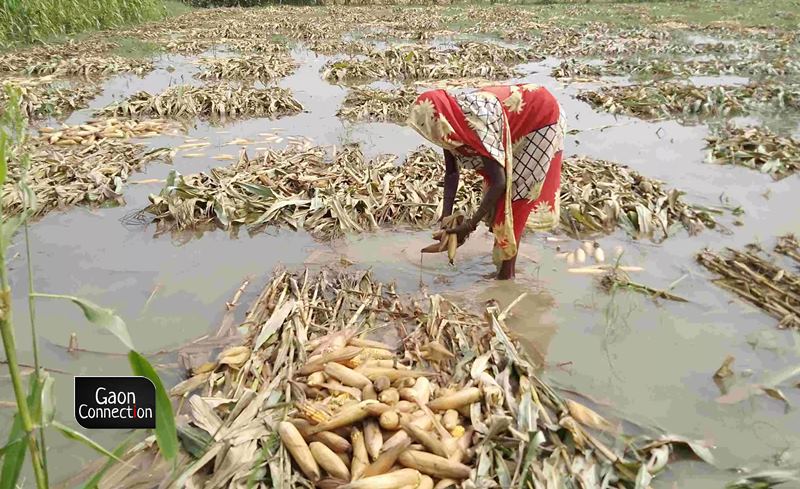Kannauj, Uttar Pradesh
Almost four months back, Manju Devi gathered courage to improve her livelihood and planned her mixed crop of maize, cauliflower and peanut. But the 40-year-old farmer didn’t have the capital required to undertake the enterprise.
What followed was a visit to the local sunaar (goldsmith) to avail a loan of Rs 40,000 at an interest rate of 10 per cent. She was also asked to mortgage her most cherished belonging — jewellery. But four months later, the sight of her ripe maize crop rotting in knee-deep water infuriates Manju as she thinks of the tedious effort she put in raising the crop.
“No afsar (official) has come to assess my damage. All my makka (corn) and gobhi (cauliflower) are spoiled. It rained too heavily in the last 10-12 days. I was about to harvest my crop but it’s all gone now. I wonder how I will pay the loan and get my jewellery back,” Manju Devi, a resident of Tighra village in Kannauj district’s Tirwa block sighed as she talked to Gaon Connection.
Also Read: Suicide by a young farmer in Khargone shines a spotlight on the farming crisis
“I have lost aath beegha (about a hectare) of makayi (maize) crop and a beegha (quarter of an hectare) of cauliflower and peanuts to heavy rains. My harvest is flowing down the drain,”she added.
According to the India Meteorological Department (IMD), the precipitation in Kannauj district has been more than twice the expected rainfall for the month of September.
Also Read: Farmers in Himachal Pradesh raise a hue and cry over the ‘unfair’ pricing of apples
The average rainfall for Kannauj district is 148.4 millimetres (mm) but so far, the district has recorded precipitation amounting to 312.4 mm (September 1-September 27) which is 110.5 per cent greater than the normal rainfall.
Similar is the experience of Nanhe Lal, Manju Devi’s neighbour from Tighra village which is situated at a distance of about 150 kilometres from the state capital Lucknow.
“I had sold my buffalo to raise the input cost for my potato crop. But heavy rains have spoiled it all. My potatoes are rotting in the field and it has cost me a loss of about Rs 20,000,” 48-year-old Nanhe Lal told Gaon Connection.
“I have informed the lekhpal (rural revenue officer) about my loss. He told me that he will visit my field for the damage assessment in a day or two,” Nanhe Lal added.
‘No compensation for losses less than 33 per cent’
The additional district magistrate in Kannauj informed Gaon Connection that the state administration has tasked the district officials to assess the damage caused by the heavy rainfall.
Also Read: Keedi Ram owned 12 bigha of land. But floods in the Ghaghra river have made him landless.
“For a crop loss to be compensated due to natural disasters, the damage should be more than 33 per cent. But that hasn’t happened here in Kannauj,” Gajendra Kumar said.
But when Gaon Connection told the ADM about the Tighra village where Manju Devi and Nanhe Lal are reeling under losses and the damage is seemingly way above 33 per cent as entire fields are submerged, Kumar stated that the fields will be assessed for losses.
“Do let me know if there are any such villages where losses are heavy, we will send teams to get the assessment done,” the ADM said.
Also, the deputy director of the agriculture department in Kannauj agreed with the ADM and stated that the losses are not ‘very high’ in the district.
“No farmer has registered a complaint about crop failure and there’s been no claim for compensation so far. The rules require cultivators to inform the agriculture department or the insurance company within 72 hours of crop damage,” RN Singh told Gaon Connection.
Also Read: The tihaiya farmers of Vindhya region caught in a cycle of debt and destitution


















